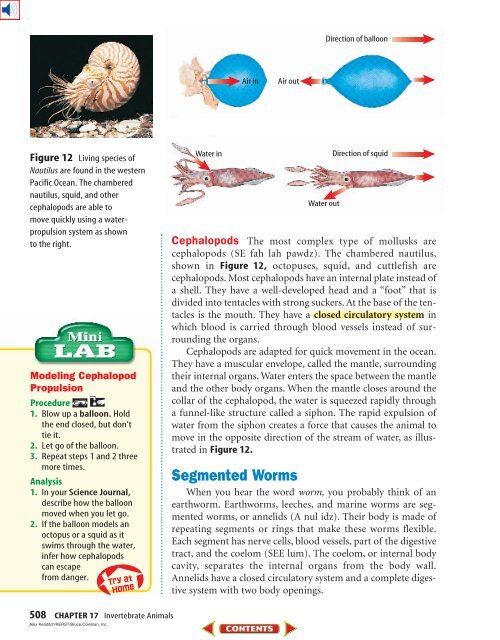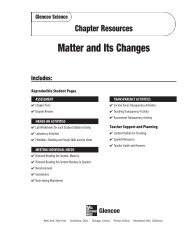Chapter 17: Invertebrate Animals
Chapter 17: Invertebrate Animals
Chapter 17: Invertebrate Animals
Create successful ePaper yourself
Turn your PDF publications into a flip-book with our unique Google optimized e-Paper software.
Direction of balloon<br />
Air in<br />
Air out<br />
Figure 12 Living species of<br />
Nautilus are found in the western<br />
Pacific Ocean. The chambered<br />
nautilus, squid, and other<br />
cephalopods are able to<br />
move quickly using a waterpropulsion<br />
system as shown<br />
to the right.<br />
Modeling Cephalopod<br />
Propulsion<br />
Procedure<br />
1. Blow up a balloon. Hold<br />
the end closed, but don’t<br />
tie it.<br />
2. Let go of the balloon.<br />
3. Repeat steps 1 and 2 three<br />
more times.<br />
Analysis<br />
1. In your Science Journal,<br />
describe how the balloon<br />
moved when you let go.<br />
2. If the balloon models an<br />
octopus or a squid as it<br />
swims through the water,<br />
infer how cephalopods<br />
can escape<br />
from danger.<br />
Water in<br />
Water out<br />
Direction of squid<br />
Cephalopods The most complex type of mollusks are<br />
cephalopods (SE fah lah pawdz). The chambered nautilus,<br />
shown in Figure 12, octopuses, squid, and cuttlefish are<br />
cephalopods. Most cephalopods have an internal plate instead of<br />
a shell. They have a well-developed head and a “foot” that is<br />
divided into tentacles with strong suckers. At the base of the tentacles<br />
is the mouth. They have a closed circulatory system in<br />
which blood is carried through blood vessels instead of surrounding<br />
the organs.<br />
Cephalopods are adapted for quick movement in the ocean.<br />
They have a muscular envelope, called the mantle, surrounding<br />
their internal organs. Water enters the space between the mantle<br />
and the other body organs. When the mantle closes around the<br />
collar of the cephalopod, the water is squeezed rapidly through<br />
a funnel-like structure called a siphon. The rapid expulsion of<br />
water from the siphon creates a force that causes the animal to<br />
move in the opposite direction of the stream of water, as illustrated<br />
in Figure 12.<br />
Segmented Worms<br />
When you hear the word worm, you probably think of an<br />
earthworm. Earthworms, leeches, and marine worms are segmented<br />
worms, or annelids (A nul idz). Their body is made of<br />
repeating segments or rings that make these worms flexible.<br />
Each segment has nerve cells, blood vessels, part of the digestive<br />
tract, and the coelom (SEE lum). The coelom, or internal body<br />
cavity, separates the internal organs from the body wall.<br />
Annelids have a closed circulatory system and a complete digestive<br />
system with two body openings.<br />
508 CHAPTER <strong>17</strong> <strong>Invertebrate</strong> <strong>Animals</strong><br />
Alex Kerstitch/KERST/Bruce Coleman, Inc.














